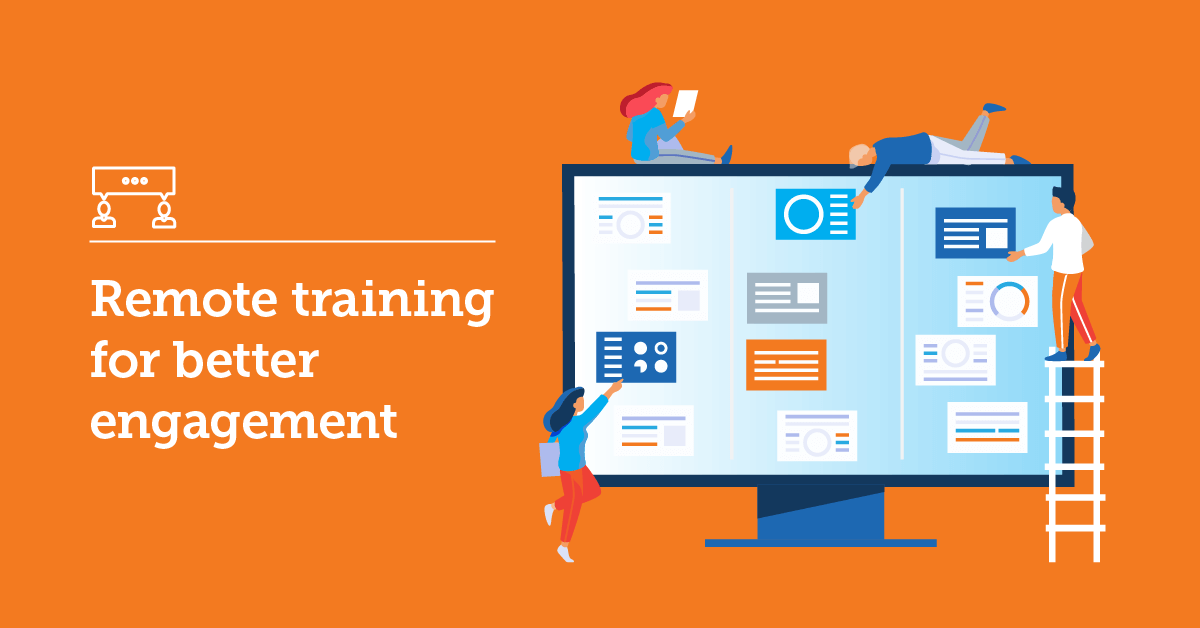While the “where” and, in many cases, the “when” we work may be different, remote work doesn’t equate to working in isolation. Or, in the case of hybrid workplaces, having to wait for the “office days” to have some real connection with the team.
If we’re actively striving to create a remote-first culture, then our online workplace interactions can and should be equally meaningful to the IRL ones. And that should permeate every aspect of the workplace: not just our daily tasks or meetings, but also our collaboration efforts and our training strategy.
Mentoring in the workplace should fall under that umbrella as well.
An extremely valuable practice that can set up younger and returning employees for success, mentoring continues to be sorely needed—but it also needs to adapt for remote and virtual settings.
Consider this article your introduction to remote mentoring for employees.
The challenges of online mentoring
Mentoring is a personal business. And it needs to be so: mentor and mentee have to build a bond of trust, in order for the knowledge imparted to have any effect.
While this process is never easy, to begin with, it becomes further complicated by the perceived distance remote work brings. The idea of virtual mentoring feels counterintuitive or “lacking” for many, precisely because they can’t see how this bond of trust can be established without the mentor’s physical presence in the mentee’s work life.
Mentoring in the workplace doesn’t always happen in a particular room or in a specific context. A lot of it is informal and spontaneous—and these are exactly the qualities that people are unsure how to reproduce mentoring in a virtual setting.
Arguably, face-to-face time between a mentor and a mentee is the best way to read social cues and see how the other person is reacting to what you’re saying. But in remote mentoring, the only substitute for that is video conferencing apps like Zoom or Skype, which can contribute to already existing screen fatigue. This creates a need to keep meetings short and to the point—which, in turn, takes away some of the opportunities to truly connect on a human level.
For remote mentoring to be successful, you need to adjust your strategy. Replicating what you had been doing when working in person won’t be as efficient.
Yet now more than ever, mentoring is important. With companies pivoting quickly to catch up with the changing times, and so many employees having to reenter the workplace after a prolonged (COVID-induced or not) absence, the already extensive skills gap is growing. A 2020 McKinsey report showed that 43% of leaders reported existing skill gaps within their teams, while a recent TalentLMS and SHRM study shows an even more concerning picture: more than 1 in 2 surveyed HR managers agree their company is facing a skills gap.
Mentoring can guide young and returning employees through the process of reentrance and reskilling/upskilling remote training in order to close the skills gap—before it becomes a skills canyon.
Building a virtual mentoring program
In case it wasn’t clear before: it’s absolutely possible to mentor people online, on a team and individual level, on an official and unofficial basis.
Of course, there are different types of remote work environments. There are teams with distributed members, teams where some people work from home and others work in the office, teams that occasionally go to the office, and so on. You need to consider the intricacies of your specific work situation as you build your online mentoring program.
Establish trust and rapport
For all the challenges of remote mentoring, there’s also something quite egalitarian about it. Research shows that visual status cues signaling organizational status and physical stature are minimized in video-based conversations. It makes sense: everyone is reduced to a voice and a window of equal size on screen, which means no one is left feeling small or worrying they take up too much space. In this egalitarian setup, establishing trust and rapport can actually become simpler.
The first step to earning your mentee’s trust is by listening. Listen to their concerns, their goals and dreams, and the challenges they face at work and at life in general. Don’t assume you know better what they want or need, just because you’re in the position of the mentor.
Ask questions; be attentive. They may not be able to physically hop by your desk next time they’re unsure about something. But if they know you’re listening, it will become much easier to use the remote communication tools at their disposal (more on that below) and write you a quick message or leave a voice note.
One way to build this relationship despite the IRL distance is by spending some time at the beginning of each meeting to chat and share thoughts with your mentee. If you don’t know where to start, you can try some team-building exercises that are possible to occur online. You could also set up a couple more casual Zoom lunches, where you can share a meal and talk about things (work included) in a more relaxed way.
Set expectations and logistics
Remote mentoring in the workplace requires better planning. From deciding how often you should communicate to which platforms feel comfortable for both of you to use, setting up clear boundaries from the start will give the mentoring relationship the opportunity to flourish.
For example, because of Zoom fatigue, it may be preferable that the bulk of your communication happens over email, or over a messaging app such as Discord or Slack. Or, due to a flexible working schedule, a weekly check-in may not always be possible—in which case alternative solutions must be found. Some days may be off-limits for religious or personal reasons. And if you and your mentee live in different time zones, you need to take that into consideration as well.
That’s why remote working tools are virtual mentoring’s best friend. Regardless of where you’ll end up chatting the most, work documents should be in one common, previously agreed upon place. That may be a shared Google Doc, a Notion document, Basecamp, Padlet, or any other tool that is constantly synced and cloud-based.
When it comes to meetings, scheduling tools such as Doodle make it easier to find and block time slots that will be good for both of you. You could also share your calendars, which will help you understand each other’s workload and which days would be too busy to connect.
Different mentees have different needs: some will require more hand-holding, while others will fare better when left to their own devices. Figuring out the right level of check-in every time will take some trial and error, but the better you get to know your mentee, the easier it’ll become to know when you need to step back and when you need to check up on them.
Find the right coaching model for each mentee (and for you)
But beyond the right level of check-in for each mentee, you also need to figure out the right coaching model for them (and the one that works better for you). There are several different coaching models, depending on whether you prefer to focus on the problems, on the solutions, or on the whole process as a more holistic approach.
For instance, the GROW coaching framework (Goal Reality Options Will) is a simple four-step process that starts with deciding on a goal and then reverse engineering your journey from there. It involves a lot of brainstorming and gives the mentee a lot of power to set up their own path—something that may feel empowering to some, but overwhelming to others. Other coaching models, like OSKAR (Outcome, Scale, Know-how, Affirm + Action, and Review), have a more collaborative approach and focus more on affirmations.
Finding the right coaching model (or creating your own approach) will depend not only on your mentee’s personality and your own time restraints, but also on the scope of the project they want to take on.
Looking for the best way to enhance remote mentoring?
Plan your online training strategy in minutes with TalentLMS.
The training platform that users consistently rank #1.
Lean into asynchronous communication…
So what happens if you can’t find a common time to meet in several weeks? If the rise of remote work taught us anything, it’s that being on the same page is more important than being at work at the same place or even at the same time.
Asynchronous communication, using email or private messaging apps, runs the inherent danger of miscommunication: your words are left there, without context, for the other person to see in a completely different setting. It can be stressful—and it’s certainly not a good solution when you need an answer or information ASAP.
But if the trust and rapport are there, then asynchronous communication becomes much more seamless. You trust that your mentee will get your message when they can, they will understand the intentions behind what you’re trying to say (or will feel comfortable enough asking for clarifications), and respond in their own time. This is key to a successful remote mentoring program.
Truth is, for many projects, asynchronous communication is a life-saver. It saves you from reacting too fast and making possible errors in judgment—or risking coming off as rude or annoyed because you didn’t have enough time to craft a thoughtful message.
…but don’t completely neglect face-time
For all its issues with fatigue, video conferencing will still be a part of your mentoring strategy. Just like with remote training where you need a mix of instructor-led, interactive sessions and asynchronous sessions, the same goes for mentoring in the workplace.

Set, track, and celebrate goals
Being a mentor means being there for all of it. The successes, the failures, the close calls. And while setting SMART goals and supporting your mentees throughout is vital, it’s equally vital to be there for them to celebrate every milestone—and offer reassurance when they don’t hit a goal.
There are many goal-setting and goal-tracking tools, from task-oriented ones like Asana and Clickup to more community-oriented ones like Coach.me. It doesn’t matter so much which tool you’ll pick. What matters most is being consistent but also human about it. Tracking their progress should be fun for your mentee—or at least not anxiety-inducing. They need to be looking forward to sharing each milestone completion with you, and in order to do that, you need to have built a solid relationship first.
Re-think the skills, too
It’s not just the “how” of mentoring in the workplace that’s changing. With the transition to remote work, the “what” will also be affected. New topics might need to be covered, to prepare your mentee for this new world of work.
A focus on soft skills, for instance, may become a bigger part of your mentoring journey. According to the TalentLMS and SHRM study, self-management will be among the top in-demand skills in 2022, with 83% of organizations focusing training initiatives on it. Similarly, agility and time management are quickly becoming very sought-after skills—and ones you could help your mentee excel in.
Meet TalentLibrary™
A growing collection of ready-made courses that cover the soft skills
your remote teams need for success at work![]()

Foster co-mentoring and collaboration
What if you can’t, or don’t want to mentor alone? When workplaces were office-bound and everyone worked on the same schedule, it was easier to build co-mentoring relationships. But how is it applicable in a remote mentoring scheme?
Switching to a remote or hybrid work environment hasn’t been easy when it comes to things like socializing or collaborating. In fact, remote employees feel like the lack of social interaction with peers and the absence of connection with what’s happening at work are two of the biggest challenges of remote work, making engagement and well-being hard to maintain.
But when you focus on efficiency and accountability and encourage hybrid and asynchronous brainstorming sessions, collaboration in remote teams is possible. So why shouldn’t it be possible in virtual mentoring as well? Even if you and your co-mentor are in different parts of the world, and this may complicate scheduling meetings a bit, it’s still worth it, as your combined skills and experience will provide your mentee with that much more value.
Ask for feedback
After each session, ask your mentee to send you a quick message with their thoughts, impressions, and suggestions. Perhaps there’s something you forgot to talk about, a different tool that could make your collaboration easier, or simply something your mentee wants to get out of their chest.
Making feedback a regular part of your mentoring relationship will highlight which processes can be tweaked and will offer valuable insight into your mentee’s needs.
And it will allow you to become a better mentor in the long run.
Mentors also need training
Being a mentor doesn’t mean you know everything; it just means that you know where to look for the things you don’t know. With work conditions changing, mentors themselves might need training on how to adjust their practices.
After all, at the heart of every successful mentoring relationship, is the need and willingness to learn together.
| Tags: Remote Employees,Remote Training



